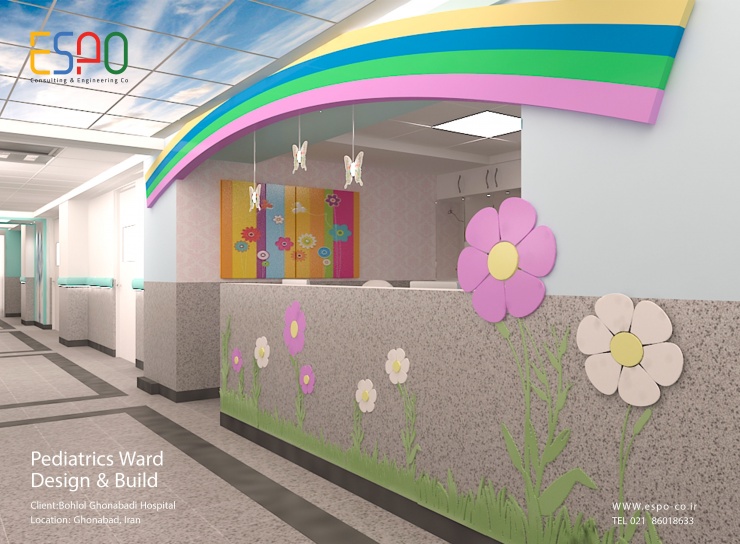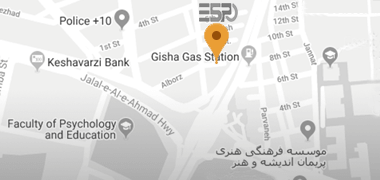
1. محیط دوستانه و آرامشبخش:
• استفاده از رنگهای شاد و ملایم که محیطی دوستانه و جذاب برای کودکان فراهم کند.
• استفاده از طرحهای گرافیکی و تمهای موضوعی که بهراحتی توجه کودکان را جلب میکند (مثل طرحهای حیوانات، شخصیتهای کودکانه، مناظر طبیعی).
2. راحتی و امنیت کودکان:
• مبلمان و تجهیزات متناسب با سنین مختلف کودکان طراحی شده و از مواد ایمن و ضدحساسیت ساخته شوند.
• کفپوشها باید نرم و ضد لغزش باشند تا از صدمات احتمالی جلوگیری شود.
• کنارهها و گوشههای دیوار و مبلمان باید بدون لبههای تیز باشند تا از آسیب جلوگیری کنند.
3. تسهیلات برای همراهان:
• در هر اتاق یا فضای بستری، فضایی برای استراحت والدین یا همراهان در نظر گرفته شود، مانند صندلیهای راحتی یا تختهای قابل تبدیل.
• فضاهایی برای استراحت و استفاده والدین با امکانات رفاهی مثل آشپزخانههای کوچک یا سالنهای انتظار باید فراهم شود.
4. تفریح و سرگرمی کودکان:
• ایجاد فضاهای بازی و تفریح مناسب برای کودکان، مثل اتاقهای بازی با اسباببازیهای آموزشی، وسایل سرگرمی و کتابهای مناسب سن.
• تلویزیونها یا سیستمهای پخش فیلم و بازیهای ویدیویی برای سرگرم کردن کودکان در طول دوره بستری.
5. نور و تهویه مناسب:
• استفاده از نور طبیعی و تهویه مناسب در تمامی فضاها برای حفظ سلامت و راحتی کودکان.
• نورپردازی نرم و غیرمستقیم که محیط را آرامشبخش و گرم جلوه دهد.
6. حریم خصوصی و مدیریت عفونت:
• ایجاد اتاقهای خصوصی یا نیمهخصوصی برای کودکان و خانوادههای آنها که حریم خصوصی را حفظ و در عین حال مراقبت از عفونتها را تسهیل کند.
• فضاهای ایزوله برای بیماران با نیاز به مراقبت ویژه یا با بیماریهای عفونی باید طراحی شوند. زیرفضاهای بخش اطفال:
1. اتاقهای بستری کودکان:
• طراحی اتاقهای خصوصی یا نیمهخصوصی با دکوراسیون کودکانه، همراه با فضای استراحت والدین.
• باید فضا برای تخت کودک، تجهیزات پزشکی، و همچنین محلی برای نگهداری وسایل شخصی وجود داشته باشد.
2. اتاق بازی و تفریح:
• فضایی با طراحی خلاقانه برای بازی و سرگرمی کودکان در طول اقامتشان.
• این فضا میتواند شامل کتابخانه کودکانه، وسایل بازی فیزیکی و الکترونیکی باشد.
3. اتاقهای مراقبت ویژه نوزادان (NICU):
• اتاقهای تخصصی برای مراقبت از نوزادان با نیازهای ویژه با تجهیزات پیشرفته و فضای مراقبتی بهینه.
4. اتاقهای معاینه و درمان:
• اتاقهایی که با ابزارها و دستگاههای مناسب برای کودکان تجهیز شدهاند و در عین حال به گونهای طراحی شدهاند که محیطی دوستانه و کم استرس باشند.
5. فضای استراحت و خدمات رفاهی برای والدین:
• فضاهایی که والدین بتوانند در طول مدت بستری کودکانشان استراحت کنند و از امکاناتی مانند اینترنت، نوشیدنی و مواد غذایی استفاده کنند.
6. سرویسهای بهداشتی ویژه کودکان:
• سرویسهای بهداشتی طراحی شده با تجهیزات و ابعاد مناسب کودکان، که همچنین دسترسی والدین به آنها را تسهیل کند. طراحی بخش اطفال بیمارستان با در نظر گرفتن تمام این جزئیات میتواند محیطی شاد و امن برای کودکان و خانوادههایشان فراهم کند و تجربه درمانی را برای آنها بهبود بخشد.










